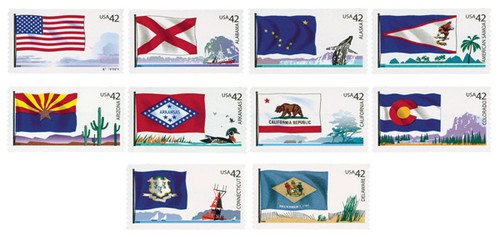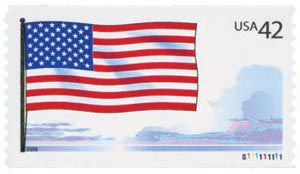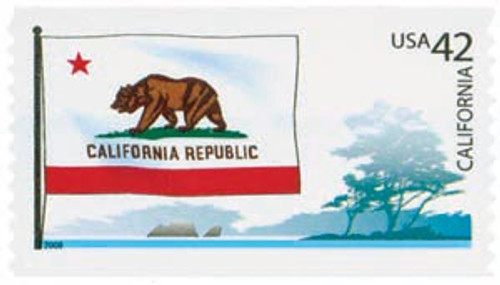
# 4273-82 - 2008 42c Flags of Our Nation - Set I
Each stamp in the Flags of Our Nation series features the state or territory's flag accompanied by a symbolic "snapshot" of the state. These include common scenes and activities in the state as well as rare wildlife and breathtaking landscapes that are normally associated with the state.
The U.S. flag, officially adopted on June 14, 1777, is one of the most enduring symbols of the American people and their principles. The blue-starred field represents the 50 states of America, with each star representing a new constellation. The 13 red stripes commemorate the 13 original Colonies.
Designed after the Secession Convention, Alabama's first official flag was known as the "Republic of Alabama" flag. During the 1861-65 war, Alabama recognized the Confederate States of America flag as its own. With the Union restored, Alabama authorized a "crimson cross of St. Andrew on a field of white" as its official flag, effective February 16, 1895.
Designed by John Bell (Benny) Benson, a 13-year-old orphaned Aleut Indian, the Alaska flag was formally adopted in May 1927. The flag's blue background represented the sky and the Forget-me-not, Alaska's state flower. Against this background are eight gold stars to represent the Big Dipper, a symbol of strength, and the North Star, to represent Alaska's future as the northernmost U.S. state.
The eagle on the American Samoa Flag represents the territory's relationship with the United States. The eagle, a symbol of power, protection, and friendship with the U.S., is seen clutching two items that are significant to the Samoan culture. In one talon it holds the uatogi, a war club symbolic of power. In the other talon it carries the fue, a ritual stick that symbolizes the wisdom of the councils.
The top half of the Arizona state flag symbolizes the original 13 American colonies and the western-setting sun. The copper star signifies Arizona's status as the largest copper-producing state in the U.S. The red and yellow colors found in the rays of the setting sun represent the colors flown by Francisco Vasquez de Coronado and the Spanish Conquistadors.
Arkansas' state flag features a white diamond on a red field, recognizing Arkansas as the only diamond-producing state at the time of the flag's creation. The blue band surrounding this diamond features 25 stars, representing Arkansas' place as the 25th state admitted to the Union. The three stars below the state name represent the three countries formerly owning the territory. The lone top star is representative of Arkansas' membership in the Confederate States of America.
The California state flag centers around a large grizzly bear. Chosen as a symbol of strength, the grizzly bear is native to the state of California. The flag also has a single, red, five-pointed star and the words "California Republic," a testament to the commitment to independence of the early California settlers.
Colorado's state flag utilizes elegant simplicity to evoke a number of significant meanings. The field consists of three stripes - two blue and one white. The blue is meant to symbolize Colorado's clear blue skies as well as the state flower, the columbine. The white stripe across the middle is said to represent the state's famous snow-capped mountains, while the red of the "C" (which stands for Colorado) reflects the color of most of the state's soil. The gold disc in the center of the "C" is meant to signify the state's history in gold mining and ample sunshine.
The Connecticut state flag consists of a blue field behind the State Seal of Connecticut. The shield, created in the rococo design (recognizable for its elaborate curvature) on the seal bears three grapevines, a symbol of good luck, peace, and proof of God's greatness. The vines are representative of the Colony carried over and planted in the unfamiliar world.
Delaware's state flag has a buff-colored diamond on a colonial blue background, representing General George Washington's uniform. The diamond is a reference to an early nickname, The Diamond State, because of Delaware's small size and great value. Inside the diamond is the Delaware coat of arms. A farmer and soldier hold up a shield with a wavy blue line (representing the Delaware River), a cow, wheat, corn, and a boat.
The Flags Of Our Nation Series
The state flags had been honored on US stamps once before, in 1976 as part of the Bicentennial Series (US #1633-82). Those stamps marked an important first – they were America’s first 50-stamp se-tenant. The sheet featured all of the state flags in the order the states were admitted to the Union.
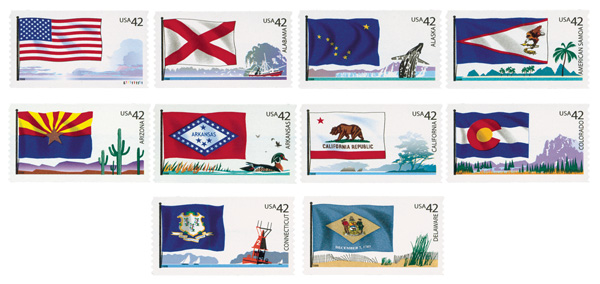
In 2008, the USPS again decided to honor the state flags but in a different format. These stamps represented a US postal first. They have the beauty and historic significance of commemorative stamps, but were issued as se-tenant (face-different attached) definitive coil stamps.Â
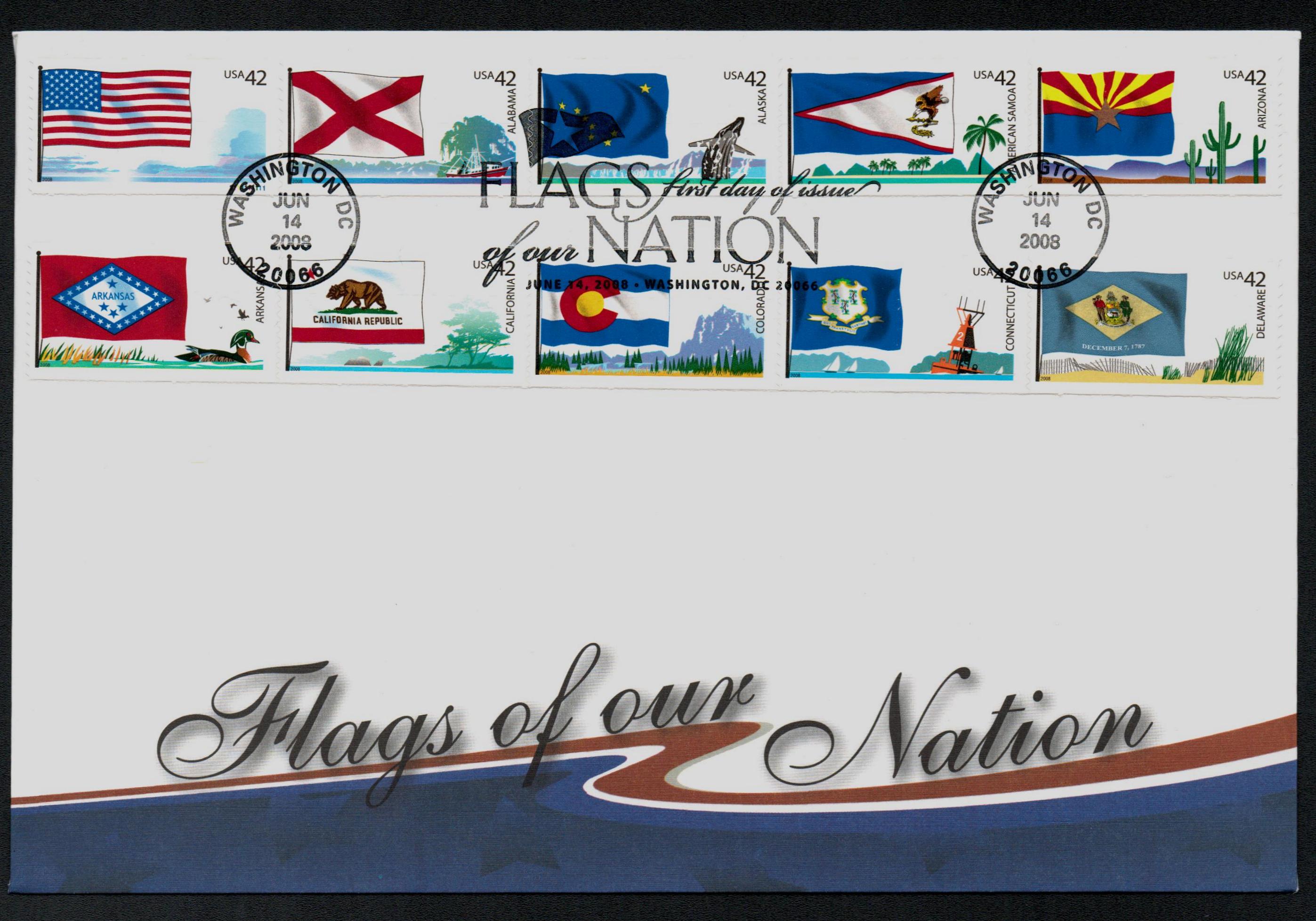
The new series was called “Flags of Our Nation†and would consist of 60 stamps total – 50 featuring state flags, five territorial flags, the District of Columbia flag, and four US flags flying over American landscapes described in “America the Beautiful.â€Â The stamps in the new set would be issued in alphabetical order by state or territory. Each stamp would feature a flag and a “snapshot†from the state or territory. These snapshots would include scenic areas, plants, animals, and more.
The first set of stamps was issued on Flag Day, June 14, 2008 at the National Postal Museum in Washington, DC. It featured the flags of Alabama through Delaware, American Samoa, and the American flag with “spacious skies.â€
In speaking about the stamps, a USPS representative said, “Flags are our nation’s greatest symbols for unity and pride and the values we hold dear. The Postal Service is proud to present this tribute as we honor our nation’s flags.â€Â That same day, special events were held in the nine state capitals whose flags were featured in that first set of stamps.Â
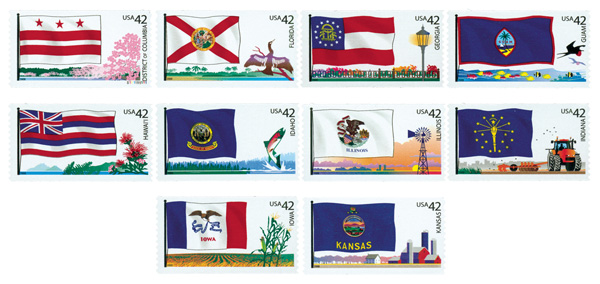
The second set in the series was issued later in 2008, on September 2. As with the first set, there were special ceremonies in the state capitols of those states featured on this set of stamps. The stamps in this set featured the flags of Florida through Kansas, the District of Columbia and Guam.Â
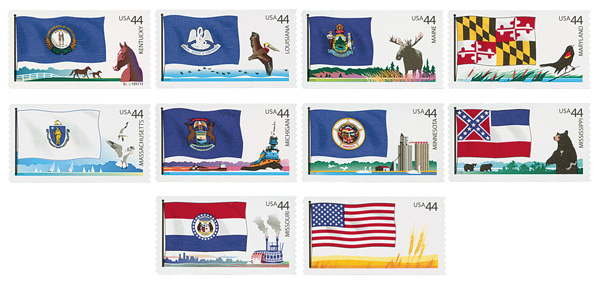
Initially, two sets of 10 stamps were supposed to be issued each year for three years. However, in 2009 it was decided that each year would only include the issue of one set of 10 stamps. The third set was issued on August 6, 2009 at the American Philatelic Society Stamp Show in Pittsburgh, Pennsylvania. These stamps featured the flags of Kentucky through Missouri as well as the US flag with “amber waves of grain.â€Â
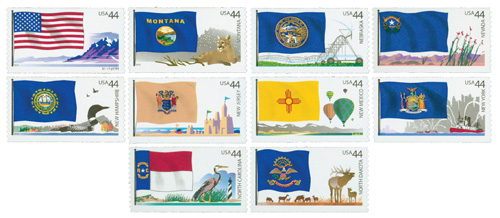
The fourth issue in the series was released on April 16, 2010 at the Mega Stamp Show in New York City. These stamps featured the flags of Montana through North Dakota with the US flag above “purple mountain majesties.â€
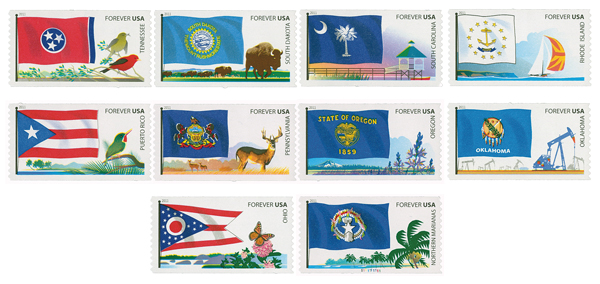
The fifth set was issued on August 11, 2011, at the American Philatelic Society Stamp Show, in Columbus Ohio. These were the first in the series to be issued as Forever stamps. Featured on these stamps were the flags of Ohio through Tennessee, Puerto Rico, and the Northern Mariana Islands.
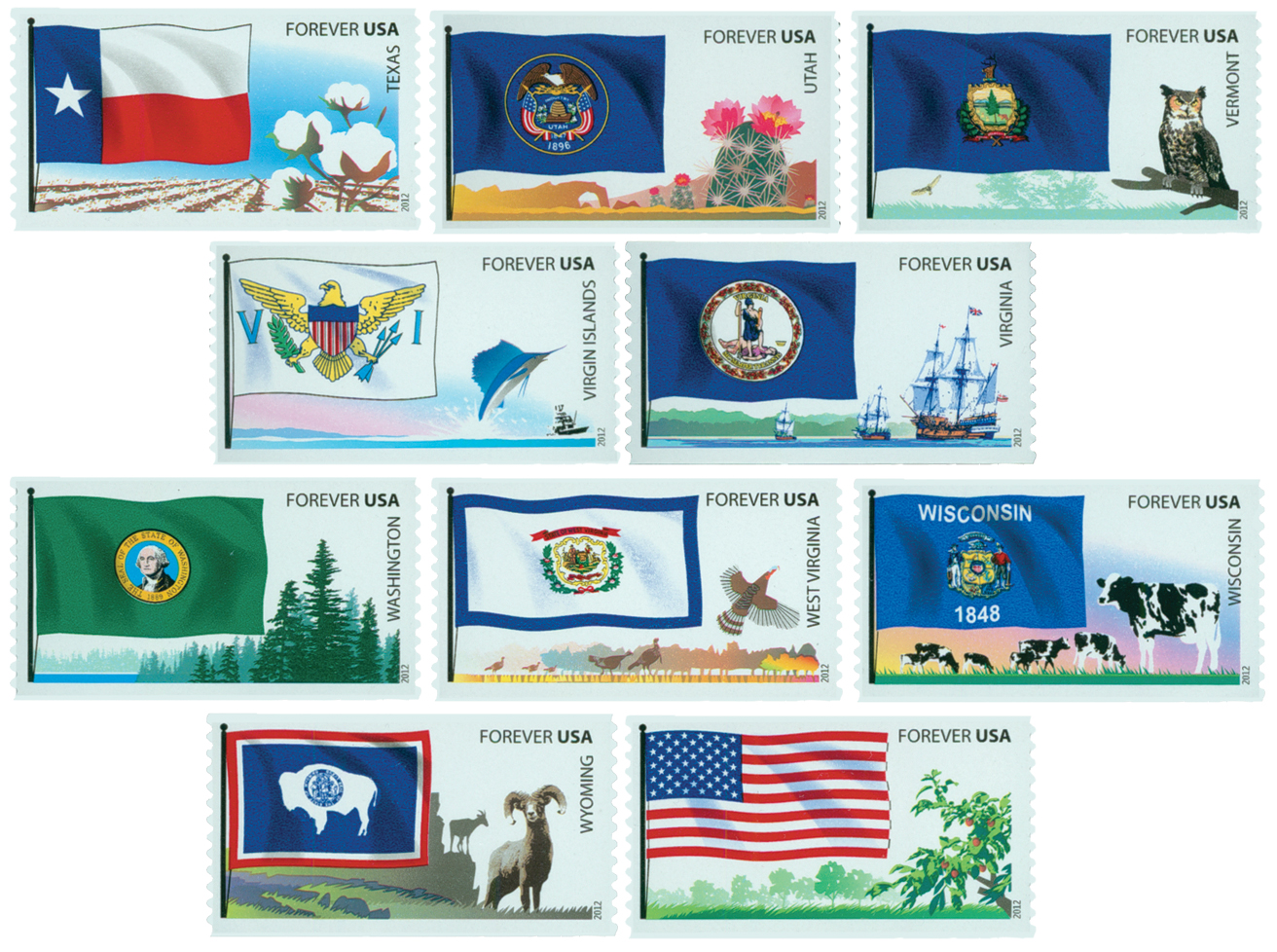
The series came to a close on August 16, 2012, with the sixth and final set. These stamps were issued at the American Philatelic Society Stamp Show in Sacramento, California. Featured on these stamps were the flags of Texas through Wyoming, the Virgin Islands, and the US flag with “the fruited plain.â€
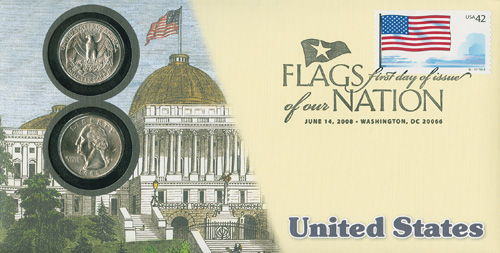
Click here for more Flags of Our Nation Coin Covers as well as single stamps and sets.Â
Click here to get the complete set of 60 Flags of Our Nation stamps in one convenient set.Â
Each stamp in the Flags of Our Nation series features the state or territory's flag accompanied by a symbolic "snapshot" of the state. These include common scenes and activities in the state as well as rare wildlife and breathtaking landscapes that are normally associated with the state.
The U.S. flag, officially adopted on June 14, 1777, is one of the most enduring symbols of the American people and their principles. The blue-starred field represents the 50 states of America, with each star representing a new constellation. The 13 red stripes commemorate the 13 original Colonies.
Designed after the Secession Convention, Alabama's first official flag was known as the "Republic of Alabama" flag. During the 1861-65 war, Alabama recognized the Confederate States of America flag as its own. With the Union restored, Alabama authorized a "crimson cross of St. Andrew on a field of white" as its official flag, effective February 16, 1895.
Designed by John Bell (Benny) Benson, a 13-year-old orphaned Aleut Indian, the Alaska flag was formally adopted in May 1927. The flag's blue background represented the sky and the Forget-me-not, Alaska's state flower. Against this background are eight gold stars to represent the Big Dipper, a symbol of strength, and the North Star, to represent Alaska's future as the northernmost U.S. state.
The eagle on the American Samoa Flag represents the territory's relationship with the United States. The eagle, a symbol of power, protection, and friendship with the U.S., is seen clutching two items that are significant to the Samoan culture. In one talon it holds the uatogi, a war club symbolic of power. In the other talon it carries the fue, a ritual stick that symbolizes the wisdom of the councils.
The top half of the Arizona state flag symbolizes the original 13 American colonies and the western-setting sun. The copper star signifies Arizona's status as the largest copper-producing state in the U.S. The red and yellow colors found in the rays of the setting sun represent the colors flown by Francisco Vasquez de Coronado and the Spanish Conquistadors.
Arkansas' state flag features a white diamond on a red field, recognizing Arkansas as the only diamond-producing state at the time of the flag's creation. The blue band surrounding this diamond features 25 stars, representing Arkansas' place as the 25th state admitted to the Union. The three stars below the state name represent the three countries formerly owning the territory. The lone top star is representative of Arkansas' membership in the Confederate States of America.
The California state flag centers around a large grizzly bear. Chosen as a symbol of strength, the grizzly bear is native to the state of California. The flag also has a single, red, five-pointed star and the words "California Republic," a testament to the commitment to independence of the early California settlers.
Colorado's state flag utilizes elegant simplicity to evoke a number of significant meanings. The field consists of three stripes - two blue and one white. The blue is meant to symbolize Colorado's clear blue skies as well as the state flower, the columbine. The white stripe across the middle is said to represent the state's famous snow-capped mountains, while the red of the "C" (which stands for Colorado) reflects the color of most of the state's soil. The gold disc in the center of the "C" is meant to signify the state's history in gold mining and ample sunshine.
The Connecticut state flag consists of a blue field behind the State Seal of Connecticut. The shield, created in the rococo design (recognizable for its elaborate curvature) on the seal bears three grapevines, a symbol of good luck, peace, and proof of God's greatness. The vines are representative of the Colony carried over and planted in the unfamiliar world.
Delaware's state flag has a buff-colored diamond on a colonial blue background, representing General George Washington's uniform. The diamond is a reference to an early nickname, The Diamond State, because of Delaware's small size and great value. Inside the diamond is the Delaware coat of arms. A farmer and soldier hold up a shield with a wavy blue line (representing the Delaware River), a cow, wheat, corn, and a boat.
The Flags Of Our Nation Series
The state flags had been honored on US stamps once before, in 1976 as part of the Bicentennial Series (US #1633-82). Those stamps marked an important first – they were America’s first 50-stamp se-tenant. The sheet featured all of the state flags in the order the states were admitted to the Union.

In 2008, the USPS again decided to honor the state flags but in a different format. These stamps represented a US postal first. They have the beauty and historic significance of commemorative stamps, but were issued as se-tenant (face-different attached) definitive coil stamps.Â

The new series was called “Flags of Our Nation†and would consist of 60 stamps total – 50 featuring state flags, five territorial flags, the District of Columbia flag, and four US flags flying over American landscapes described in “America the Beautiful.â€Â The stamps in the new set would be issued in alphabetical order by state or territory. Each stamp would feature a flag and a “snapshot†from the state or territory. These snapshots would include scenic areas, plants, animals, and more.
The first set of stamps was issued on Flag Day, June 14, 2008 at the National Postal Museum in Washington, DC. It featured the flags of Alabama through Delaware, American Samoa, and the American flag with “spacious skies.â€
In speaking about the stamps, a USPS representative said, “Flags are our nation’s greatest symbols for unity and pride and the values we hold dear. The Postal Service is proud to present this tribute as we honor our nation’s flags.â€Â That same day, special events were held in the nine state capitals whose flags were featured in that first set of stamps.Â

The second set in the series was issued later in 2008, on September 2. As with the first set, there were special ceremonies in the state capitols of those states featured on this set of stamps. The stamps in this set featured the flags of Florida through Kansas, the District of Columbia and Guam.Â

Initially, two sets of 10 stamps were supposed to be issued each year for three years. However, in 2009 it was decided that each year would only include the issue of one set of 10 stamps. The third set was issued on August 6, 2009 at the American Philatelic Society Stamp Show in Pittsburgh, Pennsylvania. These stamps featured the flags of Kentucky through Missouri as well as the US flag with “amber waves of grain.â€Â

The fourth issue in the series was released on April 16, 2010 at the Mega Stamp Show in New York City. These stamps featured the flags of Montana through North Dakota with the US flag above “purple mountain majesties.â€

The fifth set was issued on August 11, 2011, at the American Philatelic Society Stamp Show, in Columbus Ohio. These were the first in the series to be issued as Forever stamps. Featured on these stamps were the flags of Ohio through Tennessee, Puerto Rico, and the Northern Mariana Islands.

The series came to a close on August 16, 2012, with the sixth and final set. These stamps were issued at the American Philatelic Society Stamp Show in Sacramento, California. Featured on these stamps were the flags of Texas through Wyoming, the Virgin Islands, and the US flag with “the fruited plain.â€

Click here for more Flags of Our Nation Coin Covers as well as single stamps and sets.Â
Click here to get the complete set of 60 Flags of Our Nation stamps in one convenient set.Â

